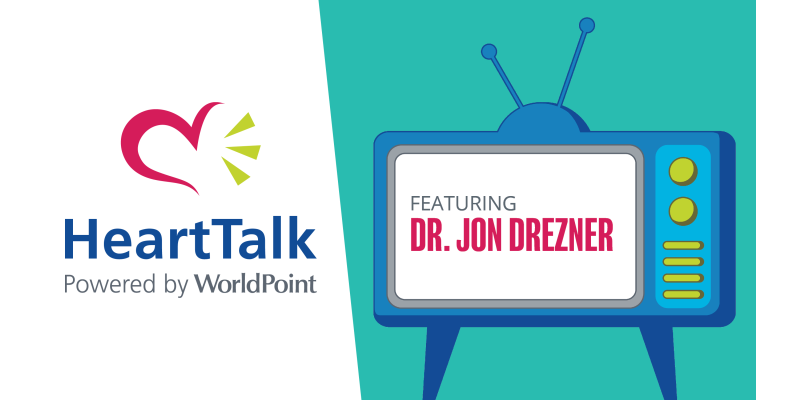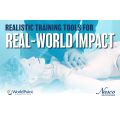HeartTalk with Dr. Jon Drezner
HeartTalk is WorldPoint’s web video interview series where we ask important questions to leading experts in the CPR and healthcare industry to learn about the topics that affect people today. Exciting, informative, and educational, HeartTalk will provide you with never-before-heard stories, real life industry experiences, and actionable takeaways. Watch HeartTalk to gain fresh and valuable insights into how we can all work together to improve patient outcomes!
We had the privilege of speaking with Dr. Jon Drezner, team physician for the NFL's Seattle Seahawks and Sports Medicine Physician at the University of Washington, at the 2023 Cardiac Arrest Survival Summit. Dr. Drezner spoke about his career in sports medicine and provided key insights on the importance of emergency action plans in youth sports.
Read the transcript below or watch the video!
Shelly
Thank you, Dr. Drezner, for joining us on HeartTalk at Summit 2023. Really excited that you are here with us today. I know that you've been speaking and so I really wanna hear about those presentations. But first, can you share a little bit about your background? You are specifically interested in youth sports and cardiology. Can you share a little bit about your background and how you came into your current profession?
Dr. Drezner
Yeah, absolutely. Well, first, thanks for having me on this. This is exciting for me as well. It's been wonderful to be at the Cardiac Arrest Survival Summit. Incredible people that are here.
I am a family medicine and sports medicine physician. I work mostly in this space of sports cardiology. I direct our Center for Sports Cardiology at the University of Washington. So a nice collaboration between sports medicine and cardiology. Our singular mission is to prevent sudden cardiac arrest and death in young persons during sports.
And this conference and this opportunity here is a chance to network with a lot of people in the same space who are working towards preventing, you know, sudden death and preventing or treating sudden cardiac arrest.
So, you know, how did that get into the sports cardiology space? I knew I wanted to go to med school. I quickly fell in love with, like, everything about medicine.
I played basketball competitively when I was young. I played basketball at Brown University. When I was in college, it was the same time that Hank Gathers had his sudden cardiac death, which was very in public view. And following that, other cases like Len Bias and others.
And so suddenly your framework for exercise leads to a healthy life and should be good for you. Suddenly you're seeing this paradox where the healthiest...healthiest-appearing athletes can have sudden cardiac arrest and made me think about it.
In medical school, got exposed to an incredible rotation at UCLA, on sports medicine, a lecture on athletes’ hearts, sudden cardiac death. And I just fell in love with the topic and eventually in residency and fellowship, did my initial sort of research in academic work in that.
And since then have just been fortunate that I found an area I'm passionate about.
Shelly
Yeah, yeah, okay! Okay so...you presented two separate sessions. Can you share a little bit about those sessions and also why?
Dr. Drezner
Yeah. So the so the first session that I presented at was the opening session, which was a real unique opportunity. [I] presented after Jeff Miller, who was vice president for the NFL. And Jeff gave a heartfelt and also personal remembrance of sort of the experience of what he went through and then what the NFL has done subsequently to the Damar Hamlin incident.
And for me, I followed that with a little bit about of the science around sudden cardiac arrest and survival. So reflecting over the last two decades. And it really is interesting to reflect how much progress we've made in the last two decades when we think about outcomes from cardiac arrest, especially in our young athletes.
So dating back from 2000 to 2006—where average survival in young athletes was about 11%—and you fast forward, you know, now, where average survival is probably upwards towards 80%. We've made a massive difference in our ability to recognize and respond to sudden cardiac arrest in that setting.
And you think about it—and sports, is that unique opportunity—you know, where else you have all these people watching and if someone drops, it's a witnessed arrest. And so we should have both the knowledge and the equipment to respond quickly and make a difference. And when you do respond quickly, when you have an AED on site, you know, survival can be over 80%, which is far different than calling 9-1-1 and having that eight, nine, ten minute delay before EMS can get there.
Shelly
Certainly.
Dr. Drezner
So bystander CPR and public access to defibrillators is really the key to improving survival.
My second talk was today, and although we've made improvement, there's still more to do and the talk today was more about gaps and how we can improve survival for sudden cardiac arrest in athletes.
I started the session by asking the audience, you know, tell me what the gaps are and tell me how we can do this better. And I think one of the messages that was loud was that, you know, there's no one solution to this, meaning there's no one policy. There's no one educational module. There's, there's no one legislation that's going to solve all of this.
It's...it's a lot of people working in the same direction, a lot of boots on the ground to raise awareness, education, more staff training, more athlete and young person training, more access to defibrillators, just sort of a better culture around sudden cardiac arrest recognition and management.
And then then we'll do better.
Shelly
And what were some of the gaps?
Dr. Drezner
I think that, you know, the first gap that was talked about—and then I also have thought about—was just general emergency action planning. And that we can do that better. Like everyone understands, the concept of an emergency action plan is absolutely critical, but we can actually do it better.
I mean, we have we have schools still that don't practice and rehearse their emergency action plan. We have coaches that should know about it, but they don't. We...we have places where sports are occurring and there's an AED there, but the people who are playing the sports and the coaches responsible for those kids don't understand when to use the AED or maybe even where it is.
And so we can we can do that better. We need to fine tune it and make sure everyone truly reviews practices and rehearses their emergency action plan before the sports season.
Another gap is that there's a lot of focus on schools and not a lot of focus on youth and sort of select sports, which is outside the school system.
And so when you have schools with athletic trainers or school nurses, administrators, there's more of a system in place to have good emergency action plans.
Now go to Select Soccer or AAU basketball or anything like that. And what is...what is the structure in the organization that says coaches need to understand what cardiac arrest is, or be trained in CPR, or know where the AEDs are, or practice and review anything. There is no structure. So, so that space for me is wide open for...for movement and for education and for good policy that we can really make a difference.
Shelly
It is wide open.
Dr. Drezner
Wide open.
Shelly
And is it policy? Is it community-based? Where do you think the first starting point is to make significant progress? Where do you start?
Dr. Drezner
All of the above is what I say, because I don't—I don't think there's any one answer. So absolutely at the ground level, community-based is a great place to start. So if you have an idea, go to your club, go to your AAU team, go to your Select Soccer team, ask your coaches, “What's your emergency action plan?”
Help your...help your kid’s sports team or club develop an emergency action plan for, say, cardiac arrest. That would be a great starting point in that can happen in your local community.
On the flip side, let's work with our national you know, our national organizations. So AAU is a national organization. You know what can we collaborate with with AAU to take our highest risk demographic, our adolescent basketball players—that seem for some reason to have the highest risk of sudden cardiac arrest—and and do more?
So can we work with the national organization to make a difference and sort of come at it from both ways? And maybe the national organization can distribute educational materials, training modules, things like that. I don't know if they can truly require it or mandate it, but they could certainly help promote it, and that would raise a lot of awareness.
Shelly
Excellent. Thank you.
You're the first author for the International Guidelines for ECG Interpretation in Athletes. Could you share some of the key insights from these guidelines and like the significance in the field?
Dr. Drezner
Sure, sure. So let's back up a step and just talk about screening. So, yes, when we're thinking about our kids playing sports and prevention of, of sudden death, you know, one aspect is the emergency action plans and having AEDs and the other side is screening.
And the purpose of screening is early detection of heart conditions at risk for for sudden death. And we'd like to think that the usual model for screening, which our kids get—you know, a sports physical, what's called a PPE or preparticipation physical evaluation—is effective. It's based traditionally on a history, a questionnaire form. And a stethoscope. And the reality is it doesn't work very well. And while the concept is good, the data and evidence just doesn't pan out.
Shelly
Something's missing.
Dr. Drezner
Absolutely. And...and the problem is that most kids who go on to have sudden cardiac arrest don't have signs or symptoms, that they have a heart problem. And so if we're asking questions, do you have chest pain, you know, have you passed out—which are important for a small subset—but if eight out of ten kids are going into cardiac arrest don't have any symptoms then we've already missed the majority of kids at risk—if we're all we're doing as a history and physical. So we need to do something better if we're serious about screening.
And at the collegiate level, at the professional level, we are doing something different, which is using an electrocardiogram or an ECG or EKG—however you want to call it. They're the same thing. So...so what is an ECG? An ECG are patches on the skin that monitor the electrical signal of the heart from different directions. And you get a tracing on a piece of paper and it's called an electrocardiogram.
And we can see evidence that might suggest there's a heart problem, either an electrical disturbance of the heart that puts people at risk for cardiac arrest or perhaps a heart muscle disease like a cardiomyopathy that can put them at risk for arrest.
The problem with or the challenge with ECG screening in young athletes is that the physiologic changes that occur in a heart when you exercise a lot can overlap a little bit with what's going on in some of the disease states. So, for instance, you know, your heart gets a little bigger and a little stronger when you exercise a lot, and that's normal and physiologic. But some of the heart muscle diseases also get a little bigger for different reasons.
And so now we have to be able to look at the ECG and distinguish findings on the ECG that suggest this is truly a problem and abnormal and suggestive of a heart condition versus findings that we can feel confident are physiologic and just related to athletic, you know, training, exercise, remodeling of the heart.
And so what the ECG interpretation criteria did—it started in 2013 with what's called the Seattle Criteria. And in 2017, the next iteration is called the International Criteria. It's took our sports cardiology experts from around the world to come to some consensus on what are in those two boxes. What can we put as these are what we consider the normal findings on an ECG in an athlete. And these are the findings we need to be concerned about, that deserve more investigation.
So when you interpret ECGs using that, sort of, those athlete specific standards, we can do much better...quality interpretation with better accuracy. Most importantly, lowering the false positive rate. So a false positive ECG, when we call the ECG abnormal, but there's really nothing wrong with the heart. And if that happens, you know, in 1% or 2% of people, that's totally acceptable. If you know one in five, one in six abnormal ECGs might show up and truly have a heart condition.
But if we're calling 10 or 20% abnormal and all of those kids have to go on and get more testing, it's a huge cost, it’s a huge burden. They might have been delayed in participation. There's harms in that and that's not acceptable. So, you know, two decades ago, the false positive rate for ECG interpretation athletes was probably 25%. I'd say on average now it's probably like 2% and it's been a massive improvement.
Shelly
Yeah.
Dr. Drezner
And so the ECG interpretation criteria has allowed ECG to really have a place in our screening protocols. And now it's just about training more providers to be able to look at an ECG accurately so we can get this out beyond professional and college, but into the high school and youth setting.
Shelly
And we're not there yet.
Dr. Drezner
We're not there yet. And it's an infrastructure issue, in my opinion. Yeah, we don't have enough physicians who are capable of accurate ECG interpretation to do that more broadly.
Shelly
Is it a cost consideration? Because I remember hearing, right, because in our local high schools, why aren’t we doing the screening—and cost kept coming up.
Dr. Drezner
Yeah.
Shelly
It's prohibitive.
Dr. Drezner
Yeah, it can be a cost issue. So let's put the cost issue on a couple of scales. So you know, the history and physical already costs, right? You're already creating a completely separate physician visit to have this sports physical and it has been shown to be the least cost-effective model, is just history and physical, so it already costs.
When you add ECG, it ranges from 25 to $50, let's say, to get an ECG. So not that much—for some people or communities that might be cost-prohibitive if your insurance doesn't cover it. You know, what really costs is not the ECG itself.
What really costs are the secondary tests you have to do if the ECG is abnormal. So if you need to get an echocardiogram or a cardiac MRI, now you're talking about costs are like $500, 1000, a couple thousand dollars, and that adds up very quickly. And so you can't have a high number of abnormal ECGs or false positives. And that's the whole point of lowering the false positive rate—now ECG becomes more cost-effective.
Shelly
Wonderful. Thank you.
So one of your presentations, as you mentioned, was about how the NFL's saved a life, right. It talks about Damar Hamlin. How has the aftermath of that incident changed actions just kind of within the sports community around response? It's not bystander CPR, obviously there was an Emergency Action Plan in place and there was a positive outcome, but can you talk a little bit about how that incident has shifted the— what's happening right now around awareness?
Dr. Drezner
Yeah, you know, the Damar Hamlin incident, I think brought sudden cardiac arrest, you know, into the dinner table conversation. Right? Suddenly everyone was sort of aware—what's this and how can this happen? And it got on everyone's mind.
And, you know, first and foremost, Damar had an incredible save and resuscitation. So glad he’s doing well. But what's happened in the aftermath has also been beautiful—meaning, you know, it was on every major, you know, TV station and radio and everyone's covering cardiac arrest and athletes and what can we do about this?
And suddenly Emergency Action Plans and the value of AEDs and the value of understanding CPR is is at the forefront. And so I think a lot has changed in the last year because of that incident.
You know, fast forward seven months and Bronny James has a cardiac arrest. And again, it's just, it's in all the newspapers—at least for a short period of time. So these elite athletes who are having cardiac arrest is an opportunity to raise greater awareness for the general public. And I do think that trickles down to the youth level.
And so in the sports medicine community, I think everyone wants to sort of tidy up their Emergency Action Plan. You know, following Damar’s case, a lot of discussion on what should be happening on the football field how do you properly conduct a resuscitation when someone's wearing shoulder pads and a helmet that makes it more difficult? What if your, you think it’s head and neck trauma? I mean, there's a lot of questions. They raise issues. But more and more, you know, we try to simplify the response and the recognition.
And so what I try to educate and promote is that if you have someone, an athlete who's been exercising and they collapse and they are unresponsive, unresponsive to a shoulder tap, unresponsive to verbal stimuli, I think you have to assume that could be cardiac arrest and you, and you start your Emergency Action Plan.You know, you really call for help. You call 9-1-1. You start chest compressions. You have someone go get the AED and use the AED as soon as possible.
Shelly
You just reminded me—I saw you showed it last night and I had seen it before. You've got something on YouTube that's been trending, incredibly, and it was so impactful. Can you share a little bit about, first of all, what it is? And then also like, why? Why did you create that?
Dr. Drezner
What's on YouTube is a YouTube video, How to Save a Life, and it's recognition of a sudden cardiac arrest in athletes. And there's lots of training videos on sudden cardiac arrest in athletes—and we've done some with with actors who do a great job—but nothing replaces the, the real live view of someone who went into sudden cardiac arrest.
And so we put together a compilation of real cases, some of which are names people know like Christian Eriksen, Damar Hamlin's in it, Marc-Vivien Foé. But there's other youth and athletes who you wouldn't know their names that are in it, but they represent what cardiac arrest looks like.
Shelly
It's so powerful.
Dr. Drezner
We try to make it digestible that if you watch this training video for 2 minutes, when you finish that video, you should have an idea of what sudden cardiac arrest in athletes looks like. And hopefully that stays with you. So if you see something like that, it will dawn on you. “Wow. I remember I saw that video. This could be cardiac arrest,” and you know what to do.
Shelly
So powerful. But then you broke down a volleyball scene.
Dr. Drezner
Yeah.
Shelly
And that was so powerful. It really resonated with me. And I think, you know, you broke it down, like, minute by minute. Can you talk a little bit about, like, why that was such a successful outcome?
Dr. Drezner
Yeah. And so this is this is a viral player named Claire who had a cardiac arrest in her high school. And what I love about her save and the video is how well the Emergency Action Plan was carried out.
And it's similar but also contrasts what happened with Damar Hamlin. So Damar Hamlin the Emergency Action Plan was carried out super well where you had a team of 20 medical professionals around him, you probably had 20 physicians on the field, right, you know, caring for him.
For Claire, there's not a single physician there. There's one medical professional and some athletic trainer, and you just have a school administrator and other people who know what to do because they've practiced an Emergency Action Plan.









